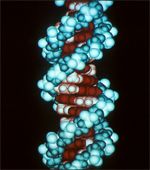New Breast Cancer Subgroups Identified Through Genomic Analysis
Researchers from the United Kingdom and Canada have released new data genetically characterizing over 2,000 breast tumors. The work provides a framework to understand how gene copy-number aberrations affect gene expression in breast cancer and reveals novel subgroups that could be targets of future investigations.

The identification of driver mutations such as HER2-overexpression in breast tumors has allowed for tailored therapies. Still, there are many aggressive tumor types that have no distinguishing genetic characteristics on which to base treatments. Research in this field is highly active.
Yesterday, researchers from the University of Cambridge and the University of British Columbia have released new data genetically characterizing over 2,000 breast tumors. The study, published in Nature, shows new breast cancer subgroups based on genomic and transcription analyses.[1] The work is a tool that provides a framework to understand “how gene copy-number aberrations affect gene expression in breast cancer and reveals novel subgroups that should be the target of future investigation,” according to the authors.
Christina Curtis, assistant professor at the University of Southern California and Keck School of Medicine and colleagues analyzed both copy number and gene-expression profiles of primary breast cancer tumor samples from tumor banks both in the United Kingdom and Canada. An initial set of 997 tumors was used as a “discover group” followed by a second group of 995 tumors used to validate the initial findings. The authors grouped mutations by somatic and germline copy number as well as by single nucleotide polymorphisms.
The authors found three new deletion mutations-PPP2R2A, MTAP, and MAP2K4. Besides PTEN, there have been little data on deletions of loci among breast cancer tumors. The deletions were specific to known breast cancer subtypes-loss of the PPP2R2A transcript was associated with estrogen-receptor (ER)–positive breast tumors. The gene is the B-regulatory subunit of the PP2A phosphatase that is implicated in the negative control of cell growth and cell division. Somatic mutations within the PPP2R2A gene have also been linked with endometrial and clear-cell ovarian cancers and silencing of the gene through methylation has been noted in colorectal cancers. MTAP is codeleted along with two tumor suppressor genes, CDKN2A and CDKN2B, in different cancers. The current study shows the first deletion of MAP2K4, a p38/Jun serine/threonine protein kinase whose mutation has been shown in cancer cell lines. The mutation occurred mostly in ER-positive breast cancers. The authors suggest MAP2K4 as a tumor suppressor gene.
The large-scale genomic analysis shows mutations that act at proximal loci, or in cis, rather than at distal loci, or in trans. These proximal-acting loci were used to cluster the tumors into subtypes. According to Curtis, one of the features that came out of the current analysis is that copy-number aberrations are associated with gene expression at distant genomic regions that are involved in shared molecular pathways of a particular subgroup of cancer.
“By delineating additional subgroups through the integration of multiple genomic features and demonstrating the reproducibility of these groupings in a validation set, this work has redefined our current understanding of the disease,” explains Curtis.
One subgroup identified is a high-risk ER-positive luminal group with mutations in four potential driver mutations that have been linked to breast and ovarian cancers. Another subgroup consisted of luminal A tumors that had few copy-number or proximal-acting mutations. The subtype had a favorable outcome. An intermediate prognosis subtype included ERBB2-amplified cancers that were either HER2-positive and ER-negative, or ER-positive. The authors noted that this subgroup verified the ERBB2 subtype that may benefit from targeted therapy.
The research also suggests evidence for an immune response to cancer. One subtype was characterized by a strong immune inflammation profile that suggests mature T-cell infiltration. The subtype contained both ER-positive and ER-negative tumor types and was largely devoid of somatic copy-number mutations.
“These findings suggest that we may be able to derive more robust patient classifiers,” said Curtis. “We are currently working to do so.”
“Additional genomic data types such as epigenetic and micro-RNA profiles may aid the further stratification of these novel subgroups since other molecular mechanisms may also be at play,” Curtis adds. Curtis and colleagues are also using the molecular stratification to prioritize representative numbers of patients from specific breast cancer subgroups for further whole-genome and targeted sequencing. The long-term goal is to determine which therapies will be most effective for patients in each subgroup.
Will sequencing a patient’s tumor before and during treatment become routine practice? Curtis believes that as sequencing technology matures and becomes more cost-effective, genomic tumor analysis will be feasible. “This strategy will allow for a more precise diagnosis and optimal treatment strategies that target the specific molecular defects present in the tumor,” Curtis said.
Reference
1. Curtis C, Shah SP, Chin SF, et al. The genomic and transcriptomic architecture of 2,000 breast tumours reveals novel subgroups. Nature. 2012 Apr 18. [Epub ahead of print]